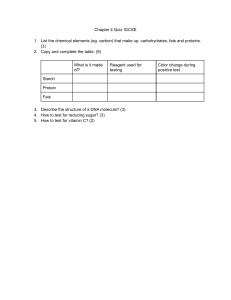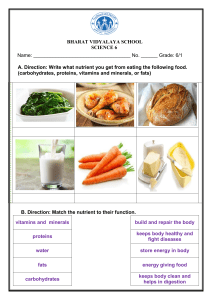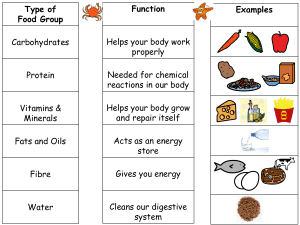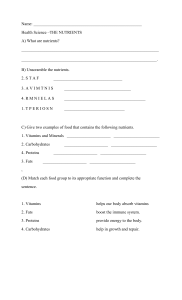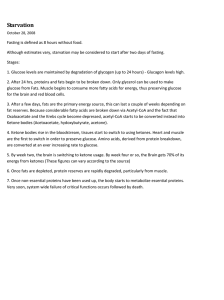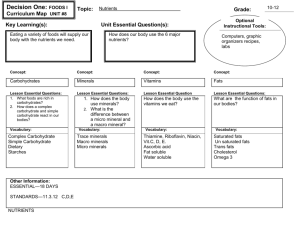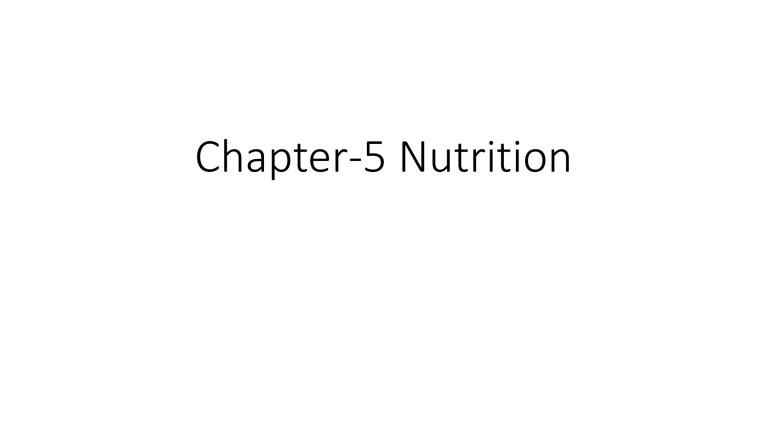
Chapter-5 Nutrition The need for food Organisms require food for one or more of the following purpose: 1. To provide energy for the vital activities of the body. 2. To synthesize new protoplasm, i.e. for growth and repair of worn out parts of the body and for reproduction. 3. To maintain health, i.e. prevent deficiency diseases. The need for energy (continued) • The energy released by food can neither be created nor destroyed but it can be converted from one form to another. • For example, muscle cells convert the energy into kinetic energy as the muscles in the body contract to move the skeleton and some energy is lost as heat energy. Nutrients in food Nutrients are chemical substances in food which nourish the body, i.e. provide energy and materials needed by the body. The nutrients in the food we eat may be classified as follows: 1. Carbohydrate 2. Fats 3. Proteins 4. Vitamins 5. Dietary fibre 6. Water 7. Mineral salts Carbohydrates, fats, proteins, vitamins and dietary fibre are called organic nutrients because they are obtained from living organisms. They are compounds of carbon. While water and mineral salts are inorganic nutrients. Carbohydrate Definition of carbohydrate: Carbohydrates are organic compounds made up of the elements carbon, hydrogen and oxygen. The hydrogen and oxygen atoms are present in the same ratio as in water, i.e. 2:1. There are three main groups of carbohydrates. Carbohydrate (continued) • Glucose is one of the simplest carbohydrates, has the formula C₆H₁₂O₆. • The generalized formula for carbohydrates is CnH2mOm. • For glucose, n=6 and m=6. But in sucrose, n = 12 and m = 11 and hence its formula is C₁₂H₂₂O₁₁. Condensation is a chemical reaction whereby two simple molecules are joined together to form a larger molecule with the removal of one molecule of water. (a)Sucrose (cane sugar, beet and carrots): Glucose + Fructose = Sucrose. b) Lactose (milk sugar): Glucose + Galactose = Lactose. c) Maltose (malted cereals and sprouting grains): Glucose + Glucose = Maltose Carbohydrate (continued) Functions of carbohydrate: 1. As a source of energy. 2. To form supporting structures, e.g. cellulose cell walls in plants. 3. To be converted to other organic compounds such as amino acids and fats. 4. For formation of nucleic acids (e.g. DNA). 5. To synthesize lubricants, e.g. mucus which consists of a carbohydrate and a protein. 6. To produce the nectar in some flowers. The sugary nectar attracts feeding insects and enables cross pollination to occur. Hydrolysis A reaction whereby a water molecule is added on to split up a complex molecule into its component units is known as hydrolysis or a hydrolytic reaction. Types of polysaccharides A polysaccharide is made up of many monosaccharide molecules joined together. The process of condensing many similar molecules to form a large molecule is called polymerization. E.g. Starch, cellulose and glycogen. Starch: Starch is made up of a very large number of glucose molecules (200 glucose units) condensed together. We can partially hydrolyze starch by using a suitable enzyme, amylase, which digests the starch to the sugar maltose. Maltose can be converted to glucose by the enzyme maltase or by heating with acid. Types of polysaccharide (continued) b) Glycogen: Glycogen is sometimes referred to as an “animal starch”. It is a storage form of carbohydrate in animals and also in fungi. In mammals, it is stored mainly in the liver and in the muscles. Glycogen and starch are suitable as storage materials because: 1. They are insoluble in water so they do not change the osmotic pressure in the cells. (osmotic pressure is the pressure required to stop osmosis) 2. They are large molecules which are unable to diffuse through the cell membranes. 3. They can easily be hydrolysed to glucose when needed. 4. Their molecules have compact shapes so they occupy less space than that occupied by all their constituent glucose molecules. Types of polysaccharide (continued) c) Cellulose: • Cellulose is the carbohydrate which forms the cell walls of plants. It consists of glucose units linked together. • Cellulose is inert and very few organisms can digest it. Man can not digest cellulose, but it forms the bulk of undigested matter. • This fibre is important to the proper functioning of the large intestine and also helps in preventing constipation. Fats Fats are organic compounds made up of elements carbon, hydrogen and oxygen but, unlike carbohydrates, they contain much less oxygen in proportion to hydrogen. When fats are hydrolyzed, they yield fatty acids and glycerol. Fats (continued) Fats are complex organic substances containing carbon, hydrogen and oxygen. Functions of fat: 1. As an efficient source and storage of energy. 2. As an insulating material. 3. As a solvent for fat-soluble vitamins. 4. As a constituent of protoplasm. 5. As a means to restrict water loss from the surface of the skin. Foods rich in fats include butter, cheese, fatty meat, olives, many nuts, and seeds of castor oil, palm oil and many leguminous plants. The types of fats: Animal fats are saturated fats and can contain cholesterol. Cholesterol may get deposited on the wall inside of arteries. This may lead to heart attack. Vegetable fats are unsaturated fats. They do not cause heart diseases. In fact, they should be substituted for animal fats as often as possible. Proteins Proteins are very complex organic substances containing carbon, hydrogen, oxygen and nitrogen. Sulphur and phosphorus are also often present. Amino acids is the basic unit of proteins. An amino acids possess an amino group (-NH₂), an acidic group (-COOH) and a hydrocarbon chain (R). The bond formed between two amino acids is strong and is known as a peptide bond. If three or more amino acids are linked up by peptide bonds, a polypeptide or peptone is formed. Proteins Polypeptides Amino Acids Proteins (continued) Effects of protein deficiency: In human beings, the average adult needs 50 to 100g of proteins a day. The deficiency of proteins in the diet of children may lead to a protein deficiency disease called kwashiorkor. Function of Proteins: 1. Essential for the synthesis of protoplasm, for growth and repair of wornout body parts. 2. Used for the synthesis of enzymes and some hormones. 3. Used in the formation of antibodies and some hormones. 4. A source of energy. DNA (deoxyribonucleic acid) Nucleic acids are essential for life. They form the genetic material of all living organisms. Nucleic acids are made up of units called nucleotides. These are arranged to form extremely long molecules known as polynucleotides. A nucleotide has three components: i) A pentose (5 carbon containing) sugar ii) A base iii) Phosphoric acid Water Water: Essential constituent of protoplasm. 70% of body weight is water. We require about 1.7L to 2L of water daily to replace water lost through the skin during sweating, as urine from the kidneys, in faeces, and by evaporation from lungs during breathing. Functions: • Require for all the chemical reactions. • Helps to regulate the body temperature and cools down the body. • As a transporting agent for digested food substances, excretory products, hormones. • Needed for digestion and photosynthesis. • An essential component of lubricant fluid in joints, digestive juice and blood. • Needed for hydrolytic reaction. Vitamins Vitamins are grouped into two categories: • Fat-soluble vitamins are stored in the body's fatty tissue. The four fat-soluble vitamins are vitamins A, D, E, and K. • There are nine water-soluble vitamins. They are not stored in the body. Any leftover watersoluble vitamins leave the body through the urine. E.g. vitamin B and C. Vitamins Sources Vitamins Vitamin C Vitamin D Deficiency Disease Functions Citrus fruits ( orange, lemon), guava, tomato, banana. For healthy skin and gums, to heal the wound quickly. Scurvy- swollen bleeding gums and loosening of teeth. Internal bleeding. Milk, butter, egg , fish. UV rays of the sun can convert a natural substance to Vit D. For strong bones and teeth. Rickets- poor teeth and bone formation in which bones become soft and may bend. Minerals: Minerals are inorganic elements which have no energy value but are required for health. Minerals Sources Milk, egg, cheese, Calcium ( 1 gram) cereals, soya beans, spinach. Iron (0.02 gram) Liver, red meat, egg, bread, flour, dark green vegetable. Functions For strong bones and teeth. For blood clotting. For normal functioning of muscles. Deficiency Disease Rickets- poor teeth and bone formation in which bones become soft and may bend. For the formation of haemoglobin in RBC. Anaemia- less haemoglobin thus less RBC, person becomes pale and tired. Dietary fibre or Roughage A type of carbohydrate (cellulose) that cannot be digested by our body because we have no enzyme that could digest cellulose, that means that roughages enter the body from the mouth, go through the digestive system, and out through the anus unchanged. Functions: • Undigested food helps to clean bowels by forming forces. • It prevents constipation. • Prevent colon cancer • Help weight-control and reduce the chance of obesity • Sources: cereals, fruits, green leafy vegetables, dried peas, nuts, lentils, grains etc Balanced diet A balanced diet is a diet that contains different kinds of foods in certain quantities and proportions so that the requirement for calories, proteins, minerals, vitamins and alternative nutrients is adequate. A balanced diet should offer around 60-70% of total calories from carbohydrates, 10-12% from proteins and 20-25% of total calories from fat. Food pyramid
